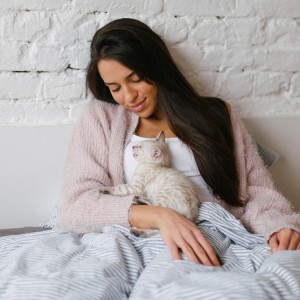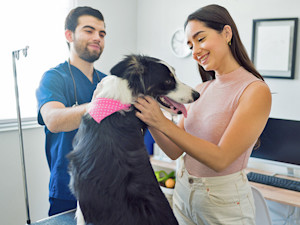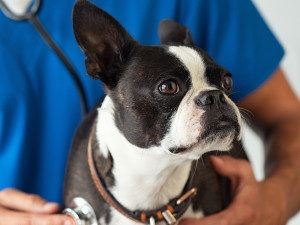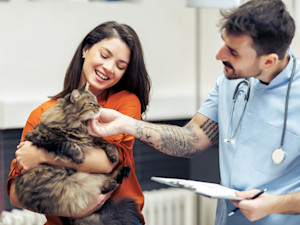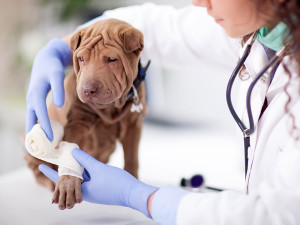How Much Is a Vet Visit for a Cat Without Insurance?
Know the facts.

Share Article
In This Article:
Typical Price Range for Cat Vet Visits Without Insurance Factors That Influence the Cost of a Vet Visit Payment Plans or Financial Assistance Programs What to Do if You Need a Vet and Have No Money
Pet insurance is becoming increasingly popular these days, and it can significantly reduce your veterinarian visit expenses. However, not everyone thinks they need it or can afford it. Many cat parents who keep their cats indoors don’t want to pay a monthly premium because they think they’ll never use the insurance. That can be true, though having insurance that excludes accident and illness as part of the policy can still be very helpful. You should be taking your cat to the vet for routine annual care, and some policies cover just that. Insurance companies like Lemonadeopens in new tab are highly customizable, so you can choose exactly what you think best benefits your pet — and without insurance, the cost can feel overwhelming.
Whether it’s a routine exam or an emergency, having an idea of what the bill will be like can help you plan, budget, and make the best decisions for your cat’s health. This guide breaks down the average cost of a vet visit for cats without insurance, items that affect pricing, and suggestions for reducing veterinary expenses, even if you’re on a tight budget.

Typical price range for cat vet visits without insurance
Without insurance, the cost of veterinary care varies widely depending on the type of visit, your location, and the specific services provided. Here’s an overview of what you might expect.
Average costs by service type
Understanding the average pricing for standard services is the first step toward being prepared. Here’s a breakdown by service category:
Routine checkups and vaccinations
Physical exam: $45–$75
Vaccinations (per shot): $15–$35
Annual wellness visit (with lab work): $100–$200
Fecal test: $25–$50
Flea/tick prevention: $15–$30 monthly
Dental care
Basic cleaning: $150–$300
Advanced cleaning or extractions: $400–$1,000-plus
Emergency visits
Emergency exam fee: $100–$200
Diagnostics (X-rays, bloodwork): $100–$400
Overnight hospitalization: $200–$800-plus
Surgery: $800–$3,000+ depending on procedure
Specialized treatments
Ultrasound: $300–$600
Echocardiogram: $500–$800
Oncology consult: $150–$300
Chemotherapy (per treatment): $200–$1,000
The cost of many of these items varies widely, and these are just estimates. For the most accurate estimates, consult your veterinarian or a local emergency clinic.
Potential additional fees
Vet bills often include more than just the exam fee. Be aware of these possible add-ons:
Medication (oral or topical): $10–$100-plus
Blood tests: $80–$200
Lab work or cultures: $100–$300
Sedation or anesthesia: $50–$300
Follow-up visits: $25–$75
Factors that influence costs of a vet visit
The significant variation in veterinary costs is due to numerous factors that influence the final cost. Here are a few examples:
Type of clinic
The type of veterinary practice plays a significant role, as there are differences between private practices, corporate clinics, non-profit or low-cost clinics, and emergency or specialty hospitals.
Private practices tend to be mid- to high-priced, depending on their location. Those in urban areas will be more expensive than those in more rural locations.
Corporate clinics (e.g., Banfield, VCA) may offer wellness plans, dental plans, or bundled senior plans that make routine care more predictable and affordable. They allow you to pay monthly instead of in one lump sum.
Nonprofit or low-cost clinics often operate with grant support or public funding, helping low-income cat parents afford pet care.
Emergency and specialty hospitals charge higher fees due to the need for 24/7 staffing, specialized equipment, and expert care.
Location
Geographic location affects everything from rent to salaries, and vet care is no exception:
Urban areas: Expect to pay more in cities like New York, Los Angeles, or San Francisco, where overhead costs are higher.
Rural or suburban areas: Prices tend to be lower, though some rural locations have limited access to specialized services.
Services required
The variety of care has a significant impact on costs. For example:
A routine exam with vaccines may be under $100, while a diagnostic workup for vomiting and lethargy could exceed $500.
Cats requiring surgery, dental extractions, or ongoing treatment for chronic illnesses like diabetes will rack up additional expenses.
Cat Health Condition
A healthy, young cat costs far less to care for than a senior cat or one with chronic health issues. Conditions like kidney disease, diabetes, hyperthyroidism, asthma, or cancer involve regular monitoring, medications, and sometimes advanced treatments, which will cost much more per visit than a young cat in for an exam and a vaccine.
Ways to manage and reduce vet costs
While your cat requires vet care at least annually, there are ways to keep the costs down.
Preventative care
Preventing illness is the most cost-effective strategy.
Routine wellness visits catch health issues early before they require expensive interventions. This is most often going to keep your cost down. If a disease is diagnosed early, it can likely be treated earlier, leading to a better outcome and a cheaper bill.
Vaccines and parasite control protect against diseases that could result in hospitalization.
Dental hygiene (e.g., brushing, dental chews, water additives) reduces the likelihood of costly cleanings or extractions.
Nutrition and weight management prevent obesity-related complications like arthritis and diabetes. Consult with your veterinarian about the optimal diet for your cat.
Comparing clinic prices
Prices vary, even within the same city. Call ahead or visit clinic websites to:
Request a pricing sheet or estimate.
Compare wellness packages.
Ask about discounts for multiple pets during a single visit.
Check for new client specials or senior citizen discounts.
Some mobile vets and vaccine clinics also offer low-cost services.
Pet Insurance
Although this article focuses on uninsured scenarios, it’s worth noting that pet insurance can protect you from high costs in the future:
Monthly premiums for cats range from $15 to $40, depending on age, breed, and coverage.
Insurance companies like Lemonadeopens in new tab offer plans that cover accidents, illnesses, and diagnostics after a deductible is met. You can also opt in for wellness coverage.
Wellness coverage (including vaccines, dental care, and flea prevention) may be offered in place of accidents and illnesses or as add-ons.
Payment plans or financial assistance programs
If your cat needs care and you’re facing a high bill, these options may help:
CareCredit: A credit card designed for your cat’s healthcare expenses, often with interest-free financing for a set period.
Scratchpay: A short-term loan system offered by many vets for bills over $200.
Clinic-specific payment plans: Some veterinarians offer in-house payment arrangements, especially for loyal or long-term clients.
Nonprofit funds: Organizations like RedRover Reliefopens in new tab, The Pet Fundopens in new tab, and Paws 4 A Cureopens in new tab offer grants or financial aid for emergency care.
What to do if you need to see a vet and have no money?
If your cat needs urgent care and finances are tight, here are actionable steps:
Call local low-cost or nonprofit veterinary clinics
Search for “low-cost vet near me” or contact local animal shelters — they often have partnerships or onsite clinics for basic services.Reach out to veterinary schools
Colleges of veterinary medicine often operate teaching hospitals that offer discounted services under the supervision of licensed vets.Explain your situation upfront
Be honest with your vet about your financial limitations. There may be more than one treatment option available. Some may prioritize critical care and delay non-urgent treatments or diagnostics.Check for community assistance
Local humane societies, churches, and animal welfare organizations sometimes have pet assistance funds available for residents in need.Apply for emergency funding
Organizations like Waggle.org and GoFundMe can help you quickly crowdsource funds during a health crisis.Look for temporary pet care or fostering
In extreme cases, temporary fostering through a rescue organization may ensure your cat gets medical care while you regain stability.
Bottom line
Cats need vet care, too. Your cat should be seen by a veterinarian at least once a year. Depending on the exam results, location, and type of facility, the bill can add up. If you absolutely can’t afford the care suggested, see our suggestions above.
There’s usually help available. A vet visit for a cat without insurance can cost as little as fifty dollars for a routine exam or soar to several thousand dollars for emergency surgery. While pet insurance isn’t required, it’s worth considering as a safeguard against unexpected high costs in the future.
References
Bir, Courtney, et al. “Familiarity and Use of Veterinary Services by US Resident Dog and Cat Owners.” opens in new tabAnimals : An Open Access Journal from MDPI, vol. 10, no. 3, 13 Mar. 2020, www.ncbi.nlm.nih.gov/pmc/articles/PMC7143178/#:~:text=According%20to%20the%202017%E2%80%932018.
Kipperman, Barry S., et al. “Factors That Influence Small Animal Veterinarians’ Opinions and Actions Regarding Cost of Care and Effects of Economic Limitations on Patient Care and Outcome and Professional Career Satisfaction and Burnout.”opens in new tab Journal of the American Veterinary Medical Association, vol. 250, no. 7, Apr. 2017, pp. 785–794, avmajournals.avma.org/view/journals/javma/250/7/javma.250.7.785.xml.
Verteramo Chiu, Leslie J., et al. “Analysis of the Demand for Pet Insurance among Uninsured Pet Owners in the United Statesopens in new tab.” Veterinary Record, vol. 189, no. 1, 18 Apr. 2021.
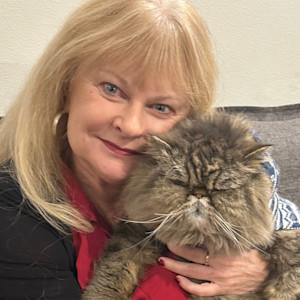
Dr. Shelby Neely, DVM
Dr. Shelby Neely is a freelance writer and veterinarian who graduated from the University of Pennsylvania School of Veterinary Medicine and has practiced veterinary medicine for 30 years, specializing in small animals. Her work has appeared in Allivet, AsktheCatDoctor, WhiskerDocs, Ask the Cat Doctor Radio, Ask the Cat Doctor TV, and numerous other websites, brochures, newsletters, newspapers, and ebooks. In her spare time, Dr. Neely likes to spend time with her three children, two grandchildren, three cats, two grand-cats, and five grand-dogs.
Related articles
![French bulldog being examined at the vet via stethoscope]()
13 Tips for Saving Money at the Vet
Ways to lower your bill—without compromising your pet’s health.
![A woman in a bright yellow-orange sweater holding a striped kitten in one hand and a credit card in the other while using her laptop in front of her]()
How to Get Help With Vet Bills for Dogs Who Need Surgery
Worried about the cost of making your pet feel better? Help is on the way.
![A woman with tattoos hugging her white cat in a cluttered, art-filled room]()
Cats, Priceless. Cat Parenthood, Not So Much
A rundown of the most common cat expenses.
![Cat's Veterinary Check-up.]()
6 Ways You Can Get Help Paying for a Pet Care Emergency
Pet insurance is ideal, but there are some other options if you're stuck.
![Dalmatian mix breed dog is playing with a dog toy on a soft surface]()
Digging into the Fine Print of Pet Insurance
Everything you need to know to understand pet insurance plans.
![A puppy getting a wound dressed at the vet]()
Which Pet Insurance Company Is Right for You?
We compared the top insurers so you don’t have to.

